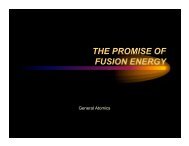Workbook: Fusion Natures Fundamental Energy Source - General ...
Workbook: Fusion Natures Fundamental Energy Source - General ...
Workbook: Fusion Natures Fundamental Energy Source - General ...
Create successful ePaper yourself
Turn your PDF publications into a flip-book with our unique Google optimized e-Paper software.
<strong>Fusion</strong> <strong>Workbook</strong><br />
The Synthesis of Elements by Atomic Number<br />
H<br />
H<br />
He<br />
1H + 1 H= 2 He<br />
He<br />
Be<br />
C<br />
He<br />
He<br />
2 He + 2 He = 4 Be<br />
He<br />
2 He + 4 Be = 6 C 2 He + 6 C = 8 O<br />
elements heavier than hydrogen in the<br />
universe (Fig. 4). In addition, during the<br />
fusion reaction a small amount of matter<br />
is “lost,” that is, converted into energy.<br />
This energy powers the thermonuclear<br />
engines of the sun and stars, and provides<br />
the energy for almost all life on<br />
earth. How can the energy source of<br />
the stars help us on earth?<br />
There’s No <strong>Energy</strong> Crisis Now, But ....<br />
Be<br />
Fig. 4 – New elements created during the fusion process.<br />
With relatively stable gas, oil, and electricity<br />
prices today, there is no longer<br />
much public concern about an energy crisis.<br />
However, in the early part of the next<br />
century at the present rate of consumption<br />
the earth’s oil gauge will start to<br />
approach empty. Natural gas reserves<br />
will hold out for about another century.<br />
C<br />
H<br />
O<br />
Our tremendous coal deposits will<br />
last several more centuries, but<br />
burning coal will come at a high<br />
environmental cost.<br />
Since 1990, over 1.3 billion metric tons<br />
per year of carbon dioxide have poured<br />
into the atmosphere in the United States<br />
alone as a result of the combustion of<br />
coal and other fossil fuels.<br />
Existing nuclear power stations are<br />
able to provide about 20% of the U.S.<br />
electricity needs. However, no new nuclear<br />
power plants are planned because of the<br />
perceived high plant cost, safety concerns<br />
and waste disposal problems.<br />
Alternative sources of electrical<br />
energy generation such as solar, geothermal,<br />
and wind (renewable resources)<br />
are being developed, but they are still<br />
expected to supply less than 15% of the<br />
nation’s electricity needs well into the<br />
next century. <strong>Fusion</strong> is a strong candidate<br />
to produce the enormous amount<br />
of electricity needed for the future in the<br />
world’s developing countries as well as<br />
the U.S.<br />
Combustion, Fission and <strong>Fusion</strong>: How do<br />
they differ?<br />
While all these reactions produce heat,<br />
they differ fundamentally in their atomic<br />
B<br />
a<br />
c<br />
k<br />
g<br />
r<br />
o<br />
u<br />
n<br />
d<br />
I<br />
n<br />
f<br />
o<br />
r<br />
m<br />
a<br />
t<br />
i<br />
o<br />
n<br />
http://<strong>Fusion</strong>Ed.gat.com<br />
5<br />
QTYUIOP




